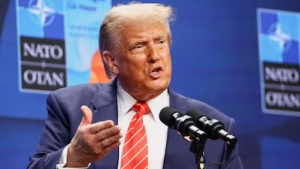Washington D.C. – US President Donald Trump has made a startling admission about the Trump China tariffs, declaring that the current duty levels imposed between the two economic superpowers are “not sustainable.” This candid acknowledgment comes just two weeks before his scheduled meeting with Chinese President Xi Jinping, raising questions about the future direction of the prolonged trade dispute between Washington and Beijing.
The Unsustainable Reality
In a revealing interview, Trump addressed the Trump China tariffs situation with unusual frankness. “It’s not sustainable,” the President stated when questioned about whether the tariffs the two countries imposed on each other earlier this year could remain in place long-term. This admission marks a significant shift in rhetoric from a leader who has consistently defended aggressive tariff policies as necessary tools for fair trade.

The Trump China tariffs acknowledgment included a defensive justification: “But that’s what the number is, it’s probably not, you know, it could stand, but they forced me to do that.” This statement suggests the President views the extreme tariff levels as a reactive measure rather than a preferred policy position, placing responsibility for the escalation on Beijing’s actions.
Historic Tariff Levels
The Trump China tariffs have reached unprecedented heights during the ongoing dispute. US import taxes on Chinese goods escalated to as high as 145 percent, representing one of the most severe tariff regimes in modern trade history. This extraordinary level of duties has stoked widespread fears of a global economic slowdown, with economists warning about the ripple effects on international supply chains and consumer prices.
The Trump China tariffs escalation reflects the deep economic tensions between the world’s two largest economies. Washington has imposed these duties citing unfair trade practices, intellectual property theft, and national security concerns, while Beijing has responded with retaliatory measures targeting American exports.
Temporary Truce and Looming Deadline
Despite the severity of the Trump China tariffs, both nations agreed to a temporary reprieve. The punitive duties were put on hold through a 90-day truce mechanism, the latest of which is scheduled to expire on November 10 unless extended by both parties. This approaching deadline adds urgency to the upcoming meeting between Trump and Xi.
The Trump China tariffs suspension provides breathing room for negotiations, but the temporary nature of this arrangement maintains pressure on both sides to reach a more permanent resolution. As the deadline approaches, businesses and markets worldwide are watching closely for signals about whether the truce will be extended or whether the full tariff regime will snap back into effect.
Upcoming Summit Meeting
Trump confirmed he would meet with Chinese President Xi Jinping in two weeks, expressing cautious optimism about the encounter. “I think we’re going to be fine with China,” the President stated, though he added caveats about ensuring fairness in any agreement reached regarding the Trump China tariffs.
The meeting is expected to occur along the sidelines of the Asia-Pacific Economic Cooperation summit in South Korea later this month. This high-stakes diplomatic encounter will provide both leaders an opportunity to negotiate directly on the Trump China tariffs and broader trade issues that have strained bilateral relations.
Trump’s Perspective on China
Despite the contentious Trump China tariffs dispute, the President maintained that he has a positive personal relationship with Xi. “I get along great with him,” Trump said, suggesting that personal rapport between the leaders might facilitate compromise on difficult economic issues.
However, Trump also acknowledged China’s negotiating approach: “China is always looking for an edge,” he observed. “I don’t know what’s going to happen. We’ll see what happens.” This statement reflects both respect for Beijing’s strategic acumen and uncertainty about the negotiation outcomes regarding the Trump China tariffs.
Also Read: Rishi Sunak India Tariffs: Powerful Call for Trust-Based Relations
Demand for Fair Deal
Central to Trump’s position on the Trump China tariffs is his insistence on achieving what he terms a “fair deal.” “I think we’re going to be fine with China, but we have to have a fair deal. It’s got to be fair,” the President emphasized, indicating that any resolution must address his administration’s concerns about trade imbalances and Chinese practices.
The Trump China tariffs, in this framework, serve as leverage to extract concessions from Beijing. The President’s willingness to acknowledge their unsustainability suggests he views them as a negotiating tool rather than a permanent policy preference.
Threats of Further Escalation
Even as Trump discussed the unsustainable nature of the Trump China tariffs, he simultaneously threatened additional escalation. Last week, the President warned of an additional 100 percent tariff on Chinese goods by November 1, demonstrating his willingness to intensify pressure if negotiations fail to produce satisfactory results.
Trump even discussed the possibility of canceling his planned meeting with Xi, though he ultimately decided to proceed. This threat-and-negotiation approach characterizes his administration’s handling of the Trump China tariffs and broader China policy.
Trade War Acknowledgment
When asked about the possibility of a trade war with China if negotiations fail, Trump’s response was blunt: “Well, you’re in one now.” This admission that the Trump China tariffs already constitute a trade war represents a frank assessment of current US-China economic relations.
“We have a 100% tariff. If we didn’t have tariffs, we would be exposed as being a nothing,” Trump added, defending the tariff strategy despite acknowledging its unsustainability. This statement reflects his belief that tariffs, however problematic, provide necessary protection for American interests.
Implications Moving Forward
The Trump China tariffs situation remains fluid as both nations approach crucial deadlines and diplomatic encounters. Trump’s admission that current levels are unsustainable opens the door for potential compromise, though significant obstacles remain. The coming weeks will determine whether the two economic giants can find common ground or whether the tariff war will intensify further, with global economic consequences.

